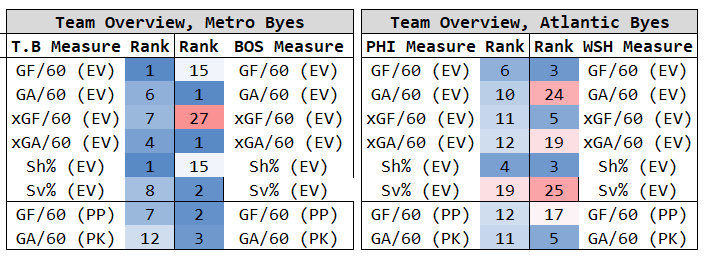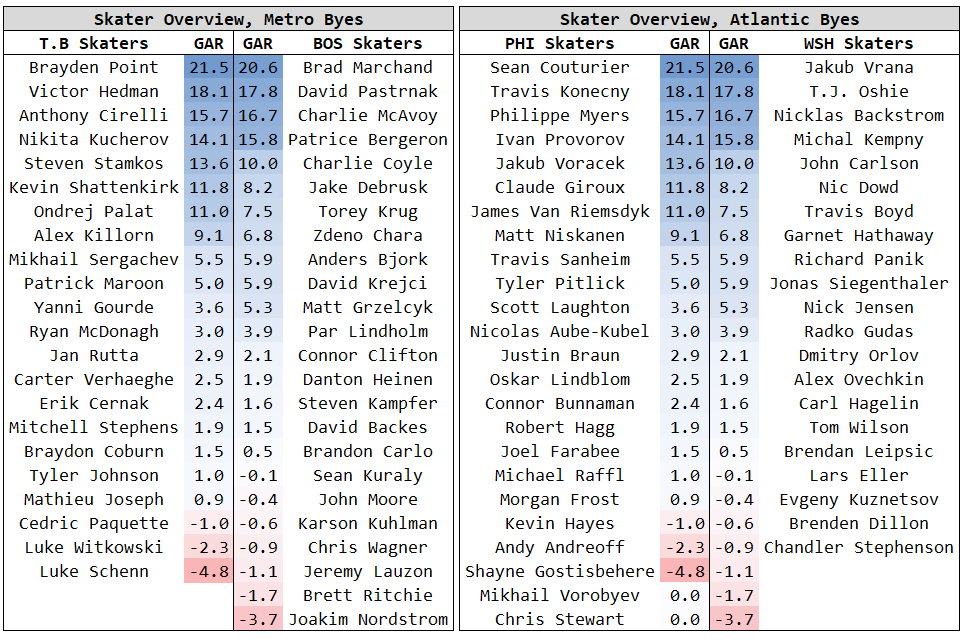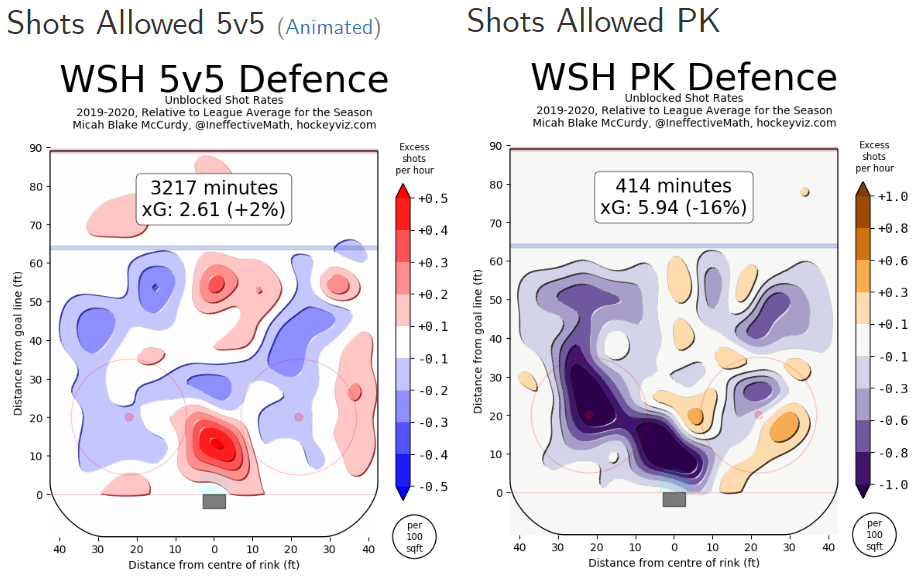Jul 13, 2020
Playoff Preview: Examining the Beasts of the East
Four great teams, and three of which figured to be in the Stanley Cup conversation way back in October. And yet, as Travis Yost writes, each has at least one critical question facing them as they enter their round robin pool.
By Travis Yost

As part of the NHL’s return to play plan, we previewed each of the eight play-in round match-ups. The return to play previews were hopefully as exciting to read as they were to write. But we would be remiss if we didn’t overview the other eight playoff competitors – the eight presumptive Stanley Cup favorites waiting in the wings for their second-round foes.
The eight teams that earned a bye from the play-in series were at the top of their respective conference standings at the time the regular season stopped. For the Eastern Conference we will preview today, the group includes the Boston Bruins, Tampa Bay Lightning, Washington Capitals, and Philadelphia Flyers – the Flyers securing a somewhat surprising bye after finishing the season on a 9-1-0 run.
Four great teams, and three of which figured to be in the Stanley Cup conversation way back in October. And yet each has at least one critical question facing them as they enter their round robin pool. Let’s look at the eight favorites, starting in the Eastern Conference, and what their biggest concern may be heading into the restart:
Team Performance, By The Numbers:

Goalie Performance, By The Numbers:

Skater Performance, By The Numbers:

Boston Bruins: Can the Bruins attack generate enough offence?
Piercing the Boston defence, time and time again, proves to be an impossible task. Patrice Bergeron, Zdeno Chara, and Tuukka Rask are routinely accredited for their defensive achievements, and justifiably so. But the defensive buy-in really pervades the entire lineup – there is complete commitment to protecting the slot and making life easy for the likes of Rask (who faces some of the lowest difficulty shots in the entire league), and it was the primary driver for Boston’s President’s Trophy quality season in 2019-20.
But the Bruins have long been a rock solid defensive team. What’s routinely been a question, spanning Claude Julien and Bruce Cassidy alike, is what they can generate on the offensive side of the ice. Part of this is because Boston’s core players have always been better playing away from the puck than with it, and part of it is because that same core has aged well into their 30s – or in Chara’s case, his mid-40s.
That’s what makes their 15th place finish in even strength scoring a bit of a concern when you are comparing them to other Stanley Cup contenders. David Pastrnak (28-goals and 29-assists; 57 points) and Brad Marchand (22-goals and 34-assists; 56 points) had big years, but the drop-off after Marchand is alarming. You would have to get to Patrice Bergeron (19-goals and 16 asissts; 35 points) to find the team’s third highest even strength scorer. So what’s the issue? Just those three players were responsible for nearly half of all of Boston’s scoring at even strength.
If Boston’s defensive tenacity sustains, they don’t need depth players in the bottom-six to do anything but trade chances and keep goals against to a minimum. But at some point they will run into a team with incredible offensive firepower – a team like, say, the Tampa Bay Lightning. And when that time comes, the pressure to score with more consistency will mount.
Tampa Bay Lightning: Can the Lightning forget about last year’s collapse?
If you are high on the Bruins, the Lightning are the second best team in the league. If you are cooler on the Bruins, the Lightning are the best team in the league. Stop me if you have heard this one before, but Tampa Bay is a freight train with no obvious single flaw and an unparalleled level of offensive firepower, backstopped by a very strong goaltender in Andrei Vaslievskiy. The team has established itself as an unstoppable scoring force at even strength, and both their power play and penalty kill units were on the right side of goal differential all year long.
I mean, just look at their depth chart. Longer-term salary cap implications aside, that is an embarrassment of riches in the talent department.
But a similarly electric team was dispatched in a sweep just one season ago, perhaps one of the bigger post-season upsets the National Hockey League has ever seen. That John Tortorella coached Columbus Blue Jackets team was quite strong defensively – they conceded just 2.8 goals per-60 minutes against during the 2018-19 season – and threw Tampa Bay’s top guns for a loop, and did so with an obvious talent disparity throughout the lineups.
It’s that reason, and perhaps that reason alone, that will give people a moment of pause when analyzing Tampa Bay’s chances come playoff time. If it’s strong defensive teams that the Lightning want to avoid, then Boston and Columbus again pose credible threats. Depending on how round robin play and the play-in series shake out, a second date with Columbus could very well be on Tampa Bay’s itinerary come August.
Washington Capitals: Can Braden Holtby return to form?
Lost in another quite successful season in Washington was the drop-off in play from veteran goaltender Braden Holtby, who has been a staple of consistency for quite some time. His save percentage (91.7 per cent) from 2012-19 ranks 10th best in the league, ahead of Hall of Fame calibre names like Roberto Luongo and Henrik Lundqvist. Adjusting for shot quality paints Holtby in an even better light over that timespan – his 63-goals saved above expectations is second only to Lundqvist over that same timespan.
But the last couple of seasons have been less encouraging from Holtby, and his 2019-20 season was a disaster. In 48-games, Holtby stopped just 89.7 per cent of shots, ranking him 47th of 51 qualified goaltenders. And those adjustments for shot quality that routinely painted Holtby in a better light over the last decade did the opposite here – Washington saw a disproportionately high volume of shots coming from less dangerous areas out on the perimeter, particularly on the penalty kill:

It goes without saying that Washington is a very, very different team with the usual Holtby in net. The one that we saw this season certainly has the feel of an outlier season, but he is on the wrong side of the aging curve and 23-year old prospect Ilya Samsonov looked much better in his 23 appearances (91.3 stop rate).
Something to keep an eye on in D.C., to be sure.
Philadelphia Flyers: How much of a burden can Sean Couturier carry?
I am not sure where Alain Vigneault will finish in the Jack Adams Trophy race, but it would not surprise me if he picked up a substantial number of votes. The Flyers didn’t just surprisingly finish in second place in an ultra-competitive Atlantic division, they did so on merit – the team was really without an obvious flaw for most of the season, and even the weak areas of the team (say, the goaltender tandem of Carter Hart and Brian Elliott) held up better than expected.
On a team that played well all season long, it can be difficult to find a single standout player. That’s not the case in Philadelphia. Sean Couturier was indisputably the team’s best player, running up one of the league’s best even-strength goal differentials this season. His +23 was 12th best amongst forwards around the league, ahead of names like Toronto’s Auston Matthews and Vancouver’s Elias Pettersson. And while Couturier has long carried a reputation as one of the league’s preeminent defensive forwards, his more recent scoring outbursts have pushed him into stardom.
Those numbers, of course, only capture a fraction of Couturier’s value. We are also talking about a skater who played well over 300 special teams minutes split between the power play and penalty kill, two other areas of the game where Couturier has a sizable impact. Vigneault hasn’t been shy about arming him with talent, either – the lion’s share of his minutes this season were played with the likes of Jakub Voracek and Claude Giroux.
That is a trio that can do serious damage come playoff time, but it’s no longer the likes of the 32-year old Giroux or the 30-year old Voracek driving the line. This is Couturier’s team now, and as he and his line go, so too will the fortunes of the Flyers.
Data via HockeyViz, NHL.com, Evolving Hockey, Hockey Reference

